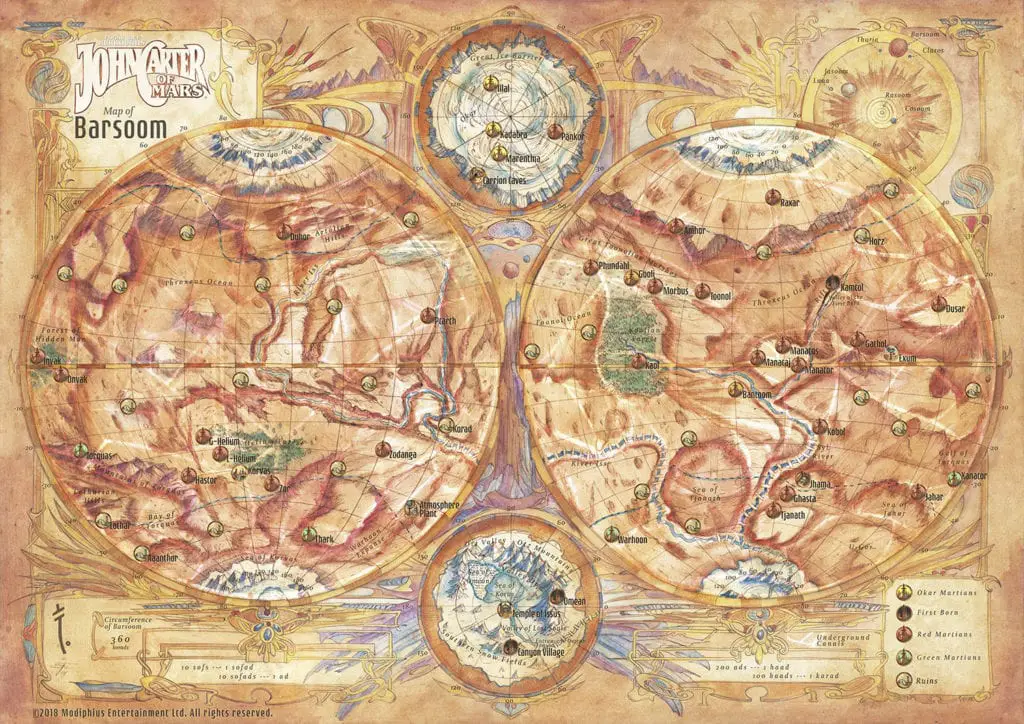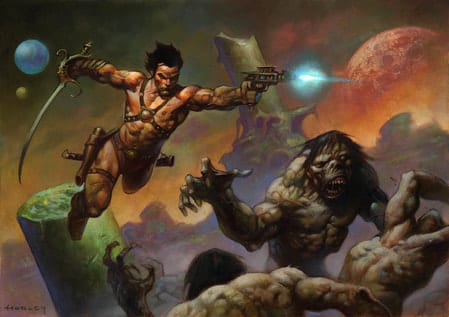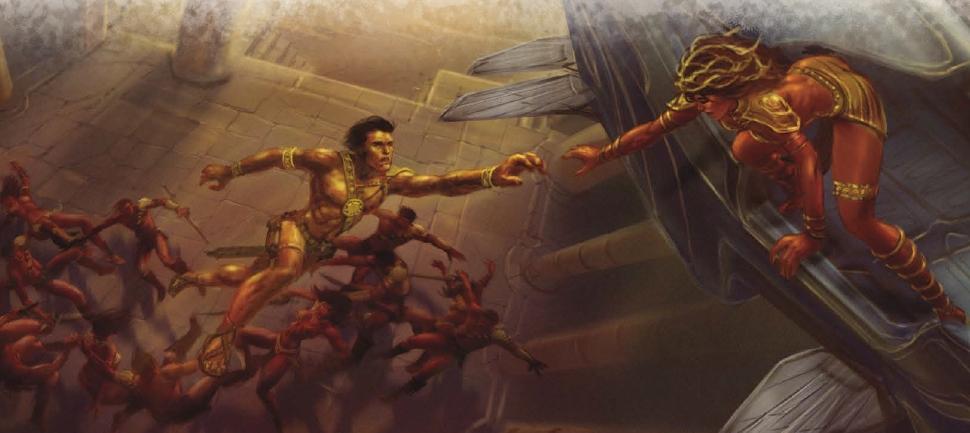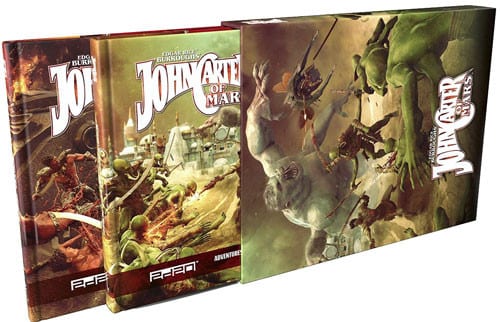Alright everyone! I’m back, with another Licensed RPG review! This time we’re going to be talking about the RPG Modiphius has made based on Edgar Rice Burroughs’s second most famous series (and his best in my opinion): John Carter of Mars (JCOM for short). The RPG successfully Kickstarted in 2018, making over 10x its goal. It’s just the first in Modiphius’s ambitious line of Barsoom adaptations for the tabletop, which also includes an extensive line of miniatures and a boardgame: John Carter: Warlord of Mars.
For those who don’t know about this particular franchise, I’ll give you a quick rundown. John Carter is a veteran soldier from Earth in the 1800’s who winds up getting transported to Mars. Once there he finds that, due to Mars’s lower gravity, he is abnormally strong and agile on the red planet. He also encounters the various races and creatures living there, who call the world Barsoom, and becomes a savior to them.
It has some flaws, being pulp fiction from the early to mid 1900’s. Being set on a different planet means that there’s…less overt racism at least, but there’s a decent amount of unfortunate coding in the races of Barsoom. And John Carter himself is a Confederate veteran which…yeah.
Fortunately though, in an RPG we don’t have to deal with John himself, which means we can avoid the more openly problematic parts of the source. So let’s dive into that RPG itself and see what’s good and what’s bad about it!
A Living, Breathing (But Still Dying) World

The world-building aspects of the JCOM RPG are genuinely quite good. A lot of effort went into it, helped along by the fact that there are 11 books and a substantial number of comics to build off of. This results in a few things that lead to a rather open-ended experience for those wishing to create a game.
First of all—and this is quite clever and helps to avoid a common issue in doing a licensed RPG—there are three eras of the world that you’re able to set your adventure in. One is set when the titular character first arrives, before he started making waves, thus allowing you to set your adventures years before he showed up without issue. Another is set during the time when John Carter was established but not quite viewed as the savior of all of Barsoom, and thus allows you to set up your own reputations, or even build a kingdom, without worrying about upsetting him. And the third is set when John Carter rules all of Barsoom, which makes making a name for yourself difficult, but allows for the most interaction with canon heroes if that’s your thing.
And that era system applies to the races you can play as too. There are five races you can play as; your backstory, culture, and how NPCs react to you will all change based on which race and what era. For example, a Green Martian from the early era will come from a very grim and almost Objectivist society, but as time passes they become a much more open and friendly people. The Okar (Yellow Martians) will be very isolationist and arrogant in the early eras, with only a vague idea of what’s happening in the rest of the world outside of their cities, but will be more involved and informed in later ones. Things like that.
It’s honestly a rather good setup. There’s enough to give both the player and the DM (here called the Narrator) plenty of information and a firm foundation (heck, there’s a not insignificant portion of the manual devoted to the history of the planet, and the cultures of the various factions of the races) but allowing for freedom to make your own choices and not be rail-roaded by the canon too much.
Pulpy, Yet Satisfying

The mechanics of the JCOM are…interesting. For one, they streamlined a lot of the typical skills balancing in favor of assuming hyper competency from all player characters. This is, after all, meant to evoke the spirit of a pulp novel, where everyone was hyper competent. What that means is that, for example, if your character hails from a race that uses airships, then your character knows how to pilot an airship. If your character hails from a race that uses guns and/or swords, than you know how to use guns and/or swords. How well exactly you know how to do these things varies, but the gist of it is there. So instead of picking skills, you pick talents, areas of emphasis within those skill trees.
Speaking of characters, the character creation process is a rather basic and easy system. The roles (here called archetypes) are laid out simply and clearly, and the game offers up a variety of example characters to help give you ideas and guide you along the path. You’ll simply need to pick your race (the game even has rules on how to help you create a mixed character if that’s something you want to try), your attributes (Daring, Cunning, Empathy, Might, Passion, and Reason, set on a scale from four to twelve (only NPCs can go lower than four) and are modified to go higher than 4 by your race, archetype, and descriptor, no dice rolling), your archetype, and your descriptor. The descriptor is a word that helps describe your character by combining the base of two attributes and gives +1 to both of the two attributes. There are fifteen descriptors, all pre-named, and cover just about every combination you could want, based on your play style.
Another mechanic is ‘complications’. Whenever you roll a 20 using a d20 on an attribute test, the Narrator is tasked with creating an obstacle to balance that out. The game specifies that it is to be an inconvenience, not a catastrophe, but it is a bit odd to have something bad happen for rolling a 20.
And finally there is ‘momentum’. The game assigns various difficulty levels to your attribute rolls based on context and your character’s background, and calls the set of rolls you must make a test. If the number of successes outweigh the difficulty level of a test, the excess become momentum. The player can choose to use that momentum immediately, in order to complete a task quicker, or hold it in reserve. You can only store as much momentum as your lowest attribute though.
Those are the three main mechanical functions that are specially for this RPG. They all fit the spirit of the source honestly. Hyper competent pulp heroes, who usually find that something is in their way when they think they’ve won, but who manage to leverage one success into another and then another. I like it.
The Only RPG Where Humans Don’t Suck

Fortunately, once you get a handle on the mechanics, gameplay is relatively easy. In terms of dice, the manual recommends two d20 for the Narrator, two more d20 for the player(s) (either communally or each, depending on preference) and six d6 for the group. That is merely the minimum number of course, you’ll likely want to bring more, but you at least don’t need the more esoteric dice for the game.
There is a major focus on movement in this game. Some of that is rolling and dodging of course, but there’s also a lot of focus on jumping, for one of the races in particular.
This is as good a time as any to address the fact that, in this game, humans (called Earthborn) are all broken as hell. That is, admittedly, due to the nature of the source material. On Earth John Carter might have been braver and smarter than the average soldier, but was otherwise nobody special. But on Barsoom, he was stronger, faster, and could jump insane distances and heights due to being from a planet with stronger gravity. And that translates to all other Earthborn characters, who just…completely and utterly break the game. Like, there are things that are threatening to a solo Earthborn, and a creative enough DM can work around it, but honestly, at the end of the day, I recommend that either nobody plays an Earthborn, or everybody plays an Earthborn. That way either you can avoid the issue entirely, or things can be scaled to accommodate the increase in power without patronizing the other players.
Once you’ve worked out the oddities of the Earthborn and the mechanics though, the JCOM RPG winds up being a fairly standard system, from a game play perspective at least.
Pretty Art, Hard To Find Rules

This is where the game sort of falls flat. On the ease of use side of things, lots of important information is located in text boxes that are located randomly throughout the pages. Well, they’re not totally random—they go in the section they belong to. But they’re not all located on the top left corner of the page or anything. Textboxes can unfortunately be easily missed, the eye sliding over them, thinking they’re flavor text rather than advice or extra information.
And from a purely aesthetic point of view…it’s fine. Nothing special, but nothing bad. It’s unlikely that anyone who doesn’t know the source will be grabbed just by flipping through the book and looking at the pictures (aside from the admittedly pretty cool cover art). Which…I view as something important to judging a rule book or manual, but isn’t strictly essential.
So overall, I’ll give Presentation a solid C. Not a mess, but not great either.
Mars Is For Everyone

I concede that I might have a skewed idea of what makes a game accessible, having been thrown in the deep end of AD&D for my first go experience, but I feel like the JCOM RPG is fairly accessible. Certain things, like the test and momentum systems, feel a little clunky when you’re reading them, but once you’ve had some time to wrap your head around it it’s fairly intuitive. The only thing you really need are the two most standard types of dice (or just a decent app), with nothing special required. No miniatures, no map, no esoteric and weirdly specific dice, nothing. So yeah, fairly accessible!
Final Verdict
The John Carter of Mars RPG is a really, really good game you guys. I mean that very sincerely. I have rarely wanted to play a game so badly as when I was reading this manual. The world of Barsoom is unlike anything else in media in general, but particularly unlike anything in tabletop roleplaying. It’s a unique and well crafted setting, with good gameplay, good mechanics, and is reasonably accessible. Seriously, play it!

You can pick up JCOM from Modiphius’s store, with the Core Rulebook available in PDF (going for $18.99) and in hardback ($52.99). There’s also all sorts of extras to pick up like themed dice sets, minis, and campaign notebooks. They recently release full-scale maps of Barsoom, as well as new tilesets for the Airships of Barsoom as well as the Ruins of Korad. Digital copies of the Core Rulebook and supplements are also available through DriveThruRPG, and physical copies can be picked up at your FLGS.
Thanks to Modiphius for the chance to check this game out, and be sure to keep an eye on The Fandomentals for the latest on the John Carter Of Mars RPG, Modiphius, and all things tabletop!
[rwp_box id=”0″]

